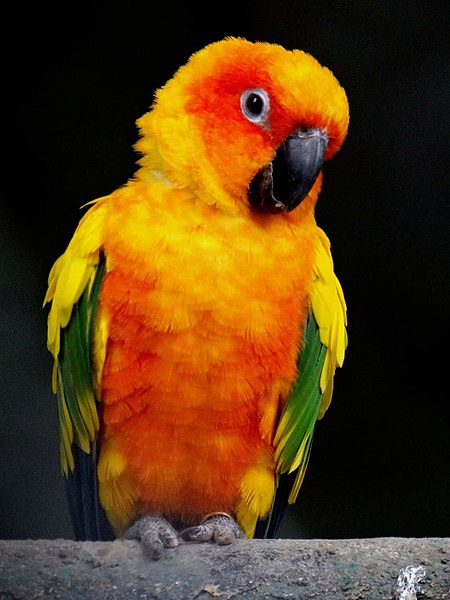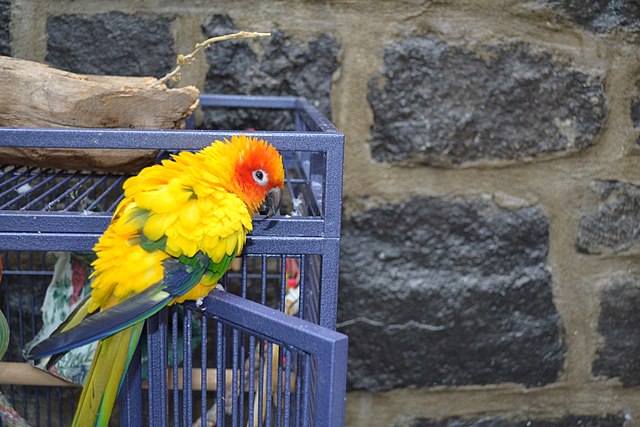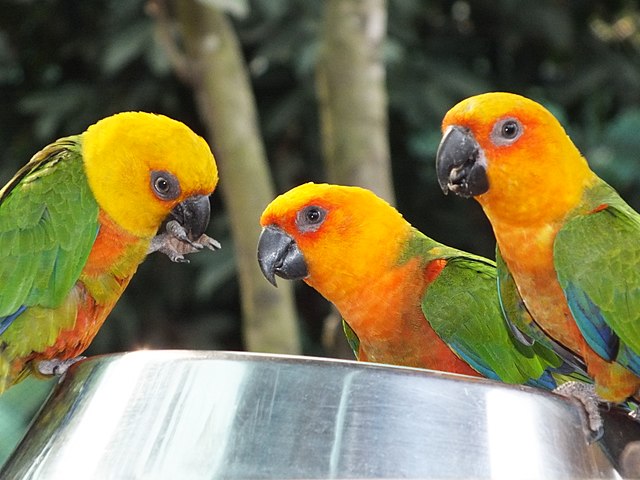Sun Conures are one of the most common birds taken into homes around the world. Like any bird, the Sun Conure is a bit of a prima donna. They’re not pets, they’re companions.
Sun Conures are extremely curious so owners will need to be diligent and make sure they have a safe environment. Additionally, they are not the bird for the owner that doesn’t have much time for interaction.
A Sun Conure wants to develop a bond with its owner which means you will need to spend time with them every day. If you cannot spend time with your Conure, they can become unhappy which will lead to behavior problems like biting and screaming

Sun Conures are also extremely vocal or to be blunter – they’re loud. If you live in an apartment or do not think you can handle their greetings and expressions of joy, you may want to look at a different bird.
Physical characteristics. Sun Conures were named because their plumage resembles the colors of the sun during a tropical sunset. They’re absolutely gorgeous and one of the most colorful birds on the planet. When they’re born they are mostly green, however, as they mature their feathers begin to take on the colors of the sunset including red, orange, yellow, blue, and green.
They grow to about 12 inches from head to tail and live an average of 25 to 30 years. This lifespan means it is important to do your research before you buy your Conure and bring it into your home.
Sun Conures bond with their owners and it can be very traumatic if they are forced to move from home to home. If difficulties do begin, they generally occur when your Conure heads into adolescence, around 1-3 years of age. If you take time to socialize, train, and bond with your Conure, you will eliminate the majority of problems that can arise during this time.
Conures originated in South America and come in two subspecies the Aratinga and Pyrrhura. The Sun Conure is of the Aratinga line along with the Jenday Conure and the Cherry Headed Conure.
While they were originally imported from South America during the early 1800s, they are easily bred in captivity and the birds you find at the pet store or aviary have most likely been bred in captivity and not captured and imported from South America.
If you’re new to bird ownership, take the time to research the Sun Conure. Visit an adult and listen to the natural sounds they make. Talk with an owner, talk with an avian veterinarian, and educate yourself on the needs of Sun Conures before you bring one home.
Make sure you have time in your day to spend with your bird, training and interacting. Make sure you have room for a cage or two in your home, time to ensure a proper diet, and the time and information to devote to their training.
Do you want to be responsible for your Sun Conures illness or bad behavior? Of course, you don’t. One of the most important things you can do to ensure a healthy happy Conure is to make sure it has a healthy and happy home. This means your Sun Conure is in the perfect cage and is eating the perfect diet. Don’t worry, it’s not too tricky to give your Sun Conure perfection.

The Perfect Sun Conure Cage
You have several considerations when choosing your Conures cage:
- Material
- Size
- Shape
- Door
- Bottom Tray
Let’s examine them each in a bit of detail.
The best material for your Sun Conure cage is stainless steel. Steel cages coated with a non-toxic paint that is durable and won’t chip off are okay too. Your Conure will chew on the cage bars and you don’t want them eating the paint.
There are also steel cages that are coated with powder paint, these cages are okay and are generally less expensive than a stainless steel cage, however, make darn sure the paint is non-toxic. It may be worth the extra expense to avoid accidentally poisoning your bird.
Size is a common source of frustration. How big should your Sun Conure’s cage be? The general rule of thumb is ‘bigger is better.’ Seriously, birds are natural roamers, climbers, and explorers – they need room to move around. Imagine sitting in a closet all day and thinking about how happy you would be.
When you’re purchasing a cage you will want your Sun Conure to be able to climb up several feet and to move around from side to side as well. A typical Sun Conure will grow to about one foot in length from tip to tail, buy your cage for your adult bird, not for your little one.
The best cage shape for a Sun Conure is a rectangle that is taller than it is wide. The reason for this is that your Conure will explore up and if the cage is round then it will be tapered at the top.
This will limit your bird’s ability to explore. A rectangle cage with a dome top is okay too. Additionally, rectangular cages are easier to place in your home, think about an open corner where your bird can look at the family and keep his back protected and to the wall.
While we’re talking about cage shape, it is important to look at the distance between the bars. You don’t want your bird to get stuck or to get out. Make sure the bars are a maximum of half an inch apart.
The perfect door, the safest door, for your Sun Conures cage is a door that opens down like a drawbridge. This type of door eliminates any kind of accident that might happen and it makes it easy for you to retrieve your Conure from its cage.
Doors that open up like a guillotine are extremely dangerous, especially for the clever and curious Sun Conure who are master of escape. Too many owners have found their birds trapped under the cage door.
Sun Conures are not generally foragers like African Greys however you will want to make sure your cage bottom has a wire grating so that waste and dropped food can fall through and be easily cleaned.
Make sure the cage bottom is far enough below the wire grating that your Conure cannot reach through the wires and retrieve food. You probably don’t want your bird eating food dropped in their waste and you don’t want them eating between meals.
Speaking of eating between meals, what are you feeding your Sun Conure?

Sun Conure Diet
Organic, not colored, pellets are the absolute best diet base for your Sun Conure. Nope, not seeds and nuts. A diet based on seeds and nuts will kill your bird. Pellets have the foundation of nutrients your bird needs every day. If you don’t know which organic pellet food to purchase or where to buy it, call your avian vet. Chances are they have a few highly recommended brands right in their office. For more information on the perfect diet see Feedyourflock.com
Now a pellet diet is only the foundation of your Conure’s diet. Your Sun Conure needs more. They need fresh fruits and veggies every day. Apples, bananas, oranges, melon, spinach, broccoli, peas celery, etc…Your Conure probably won’t like all of them. Offer them a small sampling every day and take notes on what they like and don’t like.
“But what about the seeds and nuts,” you ask…” my bird loves seeds and nuts.” Of course, they do, they’re full of fat. Save the seeds and nuts for treats and rewards during training.
The first key to a happy and healthy bird is a proper environment and a proper diet. The perfect cage environment and the perfect diet aren’t difficult to obtain. All you need to do is put a little time and effort into your cage selection process and diet. Trust me, it’s worth it – illness and discomfort always lead to behavior issues.
